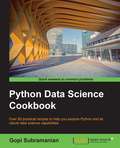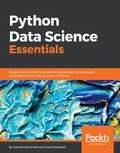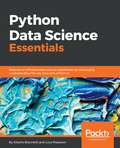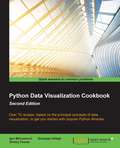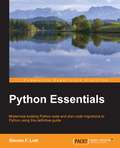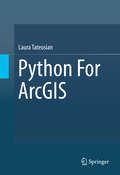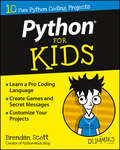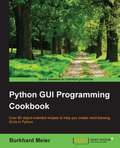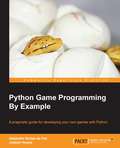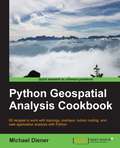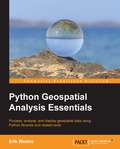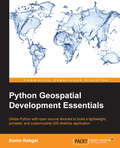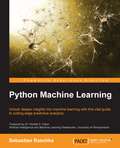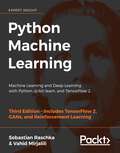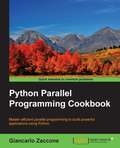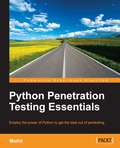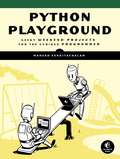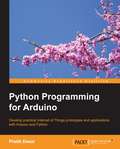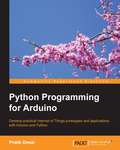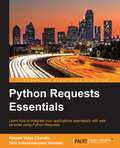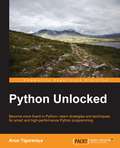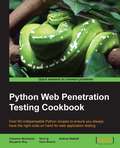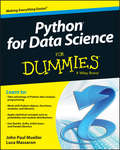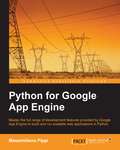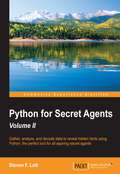- Table View
- List View
Python Data Science Cookbook
by Gopi SubramanianOver 60 practical recipes to help you explore Python and its robust data science capabilities About This Book * The book is packed with simple and concise Python code examples to effectively demonstrate advanced concepts in action * Explore concepts such as programming, data mining, data analysis, data visualization, and machine learning using Python * Get up to speed on machine learning algorithms with the help of easy-to-follow, insightful recipes Who This Book Is For This book is intended for all levels of Data Science professionals, both students and practitioners, starting from novice to experts. Novices can spend their time in the first five chapters getting themselves acquainted with Data Science. Experts can refer to the chapters starting from 6 to understand how advanced techniques are implemented using Python. People from non-Python backgrounds can also effectively use this book, but it would be helpful if you have some prior basic programming experience. What You Will Learn * Explore the complete range of Data Science algorithms * Get to know the tricks used by industry engineers to create the most accurate data science models * Manage and use Python libraries such as numpy, scipy, scikit learn, and matplotlib effectively * Create meaningful features to solve real-world problems * Take a look at Advanced Regression methods for model building and variable selection * Get a thorough understanding of the underlying concepts and implementation of Ensemble methods * Solve real-world problems using a variety of different datasets from numerical and text data modalities * Get accustomed to modern state-of-the art algorithms such as Gradient Boosting, Random Forest, Rotation Forest, and so on In Detail Python is increasingly becoming the language for data science. It is overtaking R in terms of adoption, it is widely known by many developers, and has a strong set of libraries such as Numpy, Pandas, scikit-learn, Matplotlib, Ipython and Scipy, to support its usage in this field. Data Science is the emerging new hot tech field, which is an amalgamation of different disciplines including statistics, machine learning, and computer science. It's a disruptive technology changing the face of today's business and altering the economy of various verticals including retail, manufacturing, online ventures, and hospitality, to name a few, in a big way. This book will walk you through the various steps, starting from simple to the most complex algorithms available in the Data Science arsenal, to effectively mine data and derive intelligence from it. At every step, we provide simple and efficient Python recipes that will not only show you how to implement these algorithms, but also clarify the underlying concept thoroughly. The book begins by introducing you to using Python for Data Science, followed by working with Python environments. You will then learn how to analyse your data with Python. The book then teaches you the concepts of data mining followed by an extensive coverage of machine learning methods. It introduces you to a number of Python libraries available to help implement machine learning and data mining routines effectively. It also covers the principles of shrinkage, ensemble methods, random forest, rotation forest, and extreme trees, which are a must-have for any successful Data Science Professional. Style and approach This is a step-by-step recipe-based approach to Data Science algorithms, introducing the math philosophy behind these algorithms.
Python Data Science Essentials
by Alberto Boschetti Luca MassaronIf you are an aspiring data scientist and you have at least a working knowledge of data analysis and Python, this book will get you started in data science. Data analysts with experience of R or MATLAB will also find the book to be a comprehensive reference to enhance their data manipulation and machine learning skills.
Python Data Science Essentials
by Alberto Boschetti Luca MassaronBecome an efficient data science practitioner by understanding Python's key concepts About This Book Quickly get familiar with data science using Python 3.5 Save time (and effort) with all the essential tools explained Create effective data science projects and avoid common pitfalls with the help of examples and hints dictated by experience Who This Book Is For If you are an aspiring data scientist and you have at least a working knowledge of data analysis and Python, this book will get you started in data science. Data analysts with experience of R or MATLAB will also find the book to be a comprehensive reference to enhance their data manipulation and machine learning skills. What You Will Learn Set up your data science toolbox using a Python scientific environment on Windows, Mac, and Linux Get data ready for your data science project Manipulate, fix, and explore data in order to solve data science problems Set up an experimental pipeline to test your data science hypotheses Choose the most effective and scalable learning algorithm for your data science tasks Optimize your machine learning models to get the best performance Explore and cluster graphs, taking advantage of interconnections and links in your data In Detail Fully expanded and upgraded, the second edition of Python Data Science Essentials takes you through all you need to know to suceed in data science using Python. Get modern insight into the core of Python data, including the latest versions of Jupyter notebooks, NumPy, pandas and scikit-learn. Look beyond the fundamentals with beautiful data visualizations with Seaborn and ggplot, web development with Bottle, and even the new frontiers of deep learning with Theano and TensorFlow. Dive into building your essential Python 3.5 data science toolbox, using a single-source approach that will allow to to work with Python 2.7 as well. Get to grips fast with data munging and preprocessing, and all the techniques you need to load, analyse, and process your data. Finally, get a complete overview of principal machine learning algorithms, graph analysis techniques, and all the visualization and deployment instruments that make it easier to present your results to an audience of both data science experts and business users. Style and approach The book is structured as a data science project. You will always benefit from clear code and simplified examples to help you understand the underlying mechanics and real-world datasets.
Python Data Visualization Cookbook - Second Edition
by Igor Milovanovic Giuseppe Vettigli Dimitry FouresOver 70 recipes to get you started with popular Python libraries based on the principal concepts of data visualization About This Book * Learn how to set up an optimal Python environment for data visualization * Understand how to import, clean and organize your data * Determine different approaches to data visualization and how to choose the most appropriate for your needs Who This Book Is For If you already know about Python programming and want to understand data, data formats, data visualization, and how to use Python to visualize data then this book is for you. What You Will Learn * Introduce yourself to the essential tooling to set up your working environment * Explore your data using the capabilities of standard Python Data Library and Panda Library * Draw your first chart and customize it * Use the most popular data visualization Python libraries * Make 3D visualizations mainly using mplot3d * Create charts with images and maps * Understand the most appropriate charts to describe your data * Know the matplotlib hidden gems * Use plot.ly to share your visualization online In Detail Python Data Visualization Cookbook will progress the reader from the point of installing and setting up a Python environment for data manipulation and visualization all the way to 3D animations using Python libraries. Readers will benefit from over 60 precise and reproducible recipes that will guide the reader towards a better understanding of data concepts and the building blocks for subsequent and sometimes more advanced concepts. Python Data Visualization Cookbook starts by showing how to set up matplotlib and the related libraries that are required for most parts of the book, before moving on to discuss some of the lesser-used diagrams and charts such as Gantt Charts or Sankey diagrams. Initially it uses simple plots and charts to more advanced ones, to make it easy to understand for readers. As the readers will go through the book, they will get to know about the 3D diagrams and animations. Maps are irreplaceable for displaying geo-spatial data, so this book will also show how to build them. In the last chapter, it includes explanation on how to incorporate matplotlib into different environments, such as a writing system, LaTeX, or how to create Gantt charts using Python. Style and approach A step-by-step recipe based approach to data visualization. The topics are explained sequentially as cookbook recipes consisting of a code snippet and the resulting visualization.
Python Essentials
by Steven F. LottThis book is designed for Python 2 developers who want to get to grips with Python 3 in a short period of time. It covers the key features of Python, assuming you are familiar with the fundamentals of Python 2.
Python For ArcGIS
by Laura TateosianThis book introduces Python scripting for geographic information science (GIS) workflow optimization using ArcGIS. It builds essential programming skills for automating GIS analysis. Over 200 sample Python scripts and 175 classroom-tested exercises reinforce the learning objectives. Readers will learn to: * Write and run Python in the ArcGIS Python Window, the PythonWin IDE, and the PyScripter IDE * Work with Python syntax and data types * Call ArcToolbox tools, batch process GIS datasets, and manipulate map documents using the arcpy package * Read and modify proprietary and ASCII text GIS data * Parse HTML web pages and KML datasets * Create Web pages and fetch GIS data from Web sources. * Build user-interfaces with the native Python file dialog toolkit or the ArcGIS Script tools and PyToolboxes Python for ArcGIS is designed as a primary textbook for advanced-level students in GIS. Researchers, government specialists and professionals working in GIS will also find this book useful as a reference.
Python For Kids For Dummies
by Brendan ScottThe kid-friendly way to learning coding with Python Calling all wanna-be coders! Experts point to Python as one of the best languages to start with when you're learning coding, and Python For Kids For Dummies makes it easier than ever. Packed with approachable, bite-sized projects that won't make you lose your cool, this fun and friendly guide teaches the basics of coding with Python in a language you can understand. In no time, you'll be installing Python tools, creating guessing games, building a geek speak translator, making a trivia game, constructing a Minecraft chat client, and so much more. Whether you don't have the opportunity to take coding classes at school or in camp--or just simply prefer to learn on your own--Python For Kids For Dummies makes getting acquainted with this popular coding language fast and easy. It walks you step-by-step through basic coding projects and provides lots of hands-on tasks that give you a sweet sense of accomplishment when you complete them. What's not to love about that? Navigate the basics of coding with the Python language Create your own applications and games Find help from other Python users Expand your technology skills with Python If you're a pre-to-early-teen looking to add coding skills to your creativity toolbox, Python For Kids For Dummies is your sure-fire weapon for getting up and running with one of the hottest programming languages around.
Python GUI Programming Cookbook
by Burkhard A. MeierOver 80 object-oriented recipes to help you create mind-blowing GUIs in Python About This Book * Use object-oriented programming to develop amazing GUIs in Python * Create a working GUI project as a central resource for developing your Python GUIs * Packed with easy-to-follow recipes to help you develop code using the latest released version of Python Who This Book Is For If you are a Python programmer with intermediate level knowledge of GUI programming and want to learn how to create beautiful, effective, and responsive GUIs using the freely available Python GUI frameworks, this book is for you. What You Will Learn * Create amazing GUIs with Python's built-in Tkinter module * Customize the GUIs by using layout managers to arrange the GUI widgets * Advance to an object-oriented programming style using Python * Develop beautiful charts using the free Matplotlib Python module * Use threading in a networked environment to make the GUIs responsive * Discover ways to connect the GUIs to a database * Understand how unit tests can be created and internationalize the GUI * Extend the GUIs with free Python frameworks using best practices In Detail Python is a multi-domain, interpreted programming language. It is a widely used general-purpose, high-level programming language. It is often used as a scripting language because of its forgiving syntax and compatibility with a wide variety of different eco-systems. Its flexible syntax enables developers to write short scripts while at the same time, they can use object-oriented concepts to develop very large projects. Python GUI Programming Cookbook follows a task-based approach to help you create beautiful and very effective GUIs with the least amount of code necessary. This book uses the simplest programming style, using the fewest lines of code to create a GUI in Python, and then advances to using object-oriented programming in later chapters. If you are new to object-oriented programming (OOP), this book will teach you how to take advantage of the OOP coding style in the context of creating GUIs written in Python. Throughout the book, you will develop an entire GUI application, building recipe upon recipe, connecting the GUI to a database. In the later chapters, you will explore additional Python GUI frameworks, using best practices. You will also learn how to use threading to ensure your GUI doesn't go unresponsive. By the end of the book, you will be an expert in Python GUI programming to develop a common set of GUI applications. Style and approach Every recipe in this programming cookbook solves a problem you might encounter in your programming career. At the same time, most of the recipes build on each other to create an entire, real-life GUI application.
Python Game Programming By Example
by Joseph Howse Alejandro Rodas PazA pragmatic guide for developing your own games with Python About This Book * Strengthen your fundamentals of game programming with Python language * Seven hands-on games to create 2D and 3D games rapidly from scratch * Illustrative guide to explore the different GUI libraries for building your games Who This Book Is For If you have ever wanted to create casual games in Python and you would like to explore various GUI technologies that this language offers, this is the book for you. This title is intended for beginners to Python with little or no knowledge of game development, and it covers step by step how to build seven different games, from the well-known Space Invaders to a classical 3D platformer. What You Will Learn * Take advantage of Python's clean syntax to build games quickly * Discover distinct frameworks for developing graphical applications * Implement non-player characters (NPCs) with autonomous and seemingly intelligent behaviors * Design and code some popular games like Pong and tower defense * Compose maps and levels for your sprite-based games in an easy manner * Modularize and apply object-oriented principles during the design of your games * Exploit libraries like Chimpunk2D, cocos2d, and Tkinter * Create natural user interfaces (NUIs), using a camera and computer vision algorithms to interpret the player's real-world actions In Detail With a growing interest in learning to program, game development is an appealing topic for getting started with coding. From geometry to basic Artificial Intelligence algorithms, there are plenty of concepts that can be applied in almost every game. Python is a widely used general-purpose, high-level programming language. It provides constructs intended to enable clear programs on both a small and large scale. It is the third most popular language whose grammatical syntax is not predominantly based on C. Python is also very easy to code and is also highly flexible, which is exactly what is required for game development. The user-friendliness of this language allows beginners to code games without too much effort or training. Python also works with very little code and in most cases uses the "use cases" approach, reserving lengthy explicit coding for outliers and exceptions, making game development an achievable feat. Python Game Programming by Example enables readers to develop cool and popular games in Python without having in-depth programming knowledge of Python. The book includes seven hands-on projects developed with several well-known Python packages, as well as a comprehensive explanation about the theory and design of each game. It will teach readers about the techniques of game design and coding of some popular games like Pong and tower defense. Thereafter, it will allow readers to add levels of complexities to make the games more fun and realistic using 3D. At the end of the book, you will have added several GUI libraries like Chimpunk2D, cocos2d, and Tkinter in your tool belt, as well as a handful of recipes and algorithms for developing games with Python. Style and approach This book is an example-based guide that will teach you to build games using Python. This book follows a step-by-step approach as it is aimed at beginners who would like to get started with basic game development. By the end of this book you will be competent game developers with good knowledge of programming in Python.
Python Geospatial Analysis Cookbook
by Michael DienerOver 60 recipes to work with topology, overlays, indoor routing, and web application analysis with Python About This Book * Explore the practical process of using geospatial analysis to solve simple to complex problems with reusable recipes * Concise step-by-step instructions to teach you about projections, vector, raster, overlay, indoor routing and topology analysis * Create a basic indoor routing application with geodjango Who This Book Is For If you are a student, teacher, programmer, geospatial or IT administrator, GIS analyst, researcher, or scientist looking to do spatial analysis, then this book is for you. Anyone trying to answer simple to complex spatial analysis questions will get a working demonstration of the power of Python with real-world data. Some of you may be beginners with GIS, but most of you will probably have a basic understanding of geospatial analysis and programming. What You Will Learn * Discover the projection and coordinate system information of your data and learn how to transform that data into different projections * Import or export your data into different data formats to prepare it for your application or spatial analysis * Use the power of PostGIS with Python to take advantage of the powerful analysis functions * Execute spatial analysis functions on vector data including clipping, spatial joins, measuring distances, areas, and combining data to new results * Create your own set of topology rules to perform and ensure quality assurance rules in Python * Find the shortest indoor path with network analysis functions in easy, extensible recipes revolving around all kinds of network analysis problems * Visualize your data on a map using the visualization tools and methods available to create visually stunning results * Build an indoor routing web application with GeoDjango to include your spatial analysis tools built from the previous recipes In Detail Geospatial development links your data to places on the Earth's surface. Its analysis is used in almost every industry to answer location type questions. Combined with the power of the Python programming language, which is becoming the de facto spatial scripting choice for developers and analysts worldwide, this technology will help you to solve real-world spatial problems. This book begins by tackling the installation of the necessary software dependencies and libraries needed to perform spatial analysis with Python. From there, the next logical step is to prepare our data for analysis; we will do this by building up our tool box to deal with data preparation, transformations, and projections. Now that our data is ready for analysis, we will tackle the most common analysis methods for vector and raster data. To check or validate our results, we will explore how to use topology checks to ensure top-quality results. This is followed with network routing analysis focused on constructing indoor routes within buildings, over different levels. Finally, we put several recipes together in a GeoDjango web application that demonstrates a working indoor routing spatial analysis application. The round trip will provide you all the pieces you need to accomplish your own spatial analysis application to suit your requirements. Style and approach Easy-to-follow, step-by-step recipes, explaining from start to finish how to accomplish real-world tasks.
Python Geospatial Analysis Essentials
by Erik WestraIf you are an experienced Python developer and wish to get up-to-speed with geospatial programming, then this book is for you. While familiarity with installing third-party Python libraries would be an advantage, no prior knowledge of geospatial programming is required.
Python Geospatial Development Essentials
by Karim BahgatThis book provides you with the resources to successfully develop your own GIS application in Python. The book begins by walking you through the loading and saving of data structures before you start to build the look and feel of your application and create its interactive map window. You'll then move on to managing, editing, and analyzing spatial data from within the application and finish with instructions for packaging the application for distribution. By the end of the book, you should be able to use your GIS application as a template for further development, with the potential to expand and customize it to suit your needs.
Python Machine Learning
by Sebastian RaschkaUnlock deeper insights into Machine Leaning with this vital guide to cutting-edge predictive analytics About This Book * Leverage Python's most powerful open-source libraries for deep learning, data wrangling, and data visualization * Learn effective strategies and best practices to improve and optimize machine learning systems and algorithms * Ask - and answer - tough questions of your data with robust statistical models, built for a range of datasets Who This Book Is For If you want to find out how to use Python to start answering critical questions of your data, pick up Python Machine Learning - whether you want to get started from scratch or want to extend your data science knowledge, this is an essential and unmissable resource. What You Will Learn * Explore how to use different machine learning models to ask different questions of your data * Learn how to build neural networks using Pylearn 2 and Theano * Find out how to write clean and elegant Python code that will optimize the strength of your algorithms * Discover how to embed your machine learning model in a web application for increased accessibility * Predict continuous target outcomes using regression analysis * Uncover hidden patterns and structures in data with clustering * Organize data using effective pre-processing techniques * Get to grips with sentiment analysis to delve deeper into textual and social media data In Detail Machine learning and predictive analytics are transforming the way businesses and other organizations operate. Being able to understand trends and patterns in complex data is critical to success, becoming one of the key strategies for unlocking growth in a challenging contemporary marketplace. Python can help you deliver key insights into your data - its unique capabilities as a language let you build sophisticated algorithms and statistical models that can reveal new perspectives and answer key questions that are vital for success. Python Machine Learning gives you access to the world of predictive analytics and demonstrates why Python is one of the world's leading data science languages. If you want to ask better questions of data, or need to improve and extend the capabilities of your machine learning systems, this practical data science book is invaluable. Covering a wide range of powerful Python libraries, including scikit-learn, Theano, and Pylearn2, and featuring guidance and tips on everything from sentiment analysis to neural networks, you'll soon be able to answer some of the most important questions facing you and your organization. Style and approach Python Machine Learning connects the fundamental theoretical principles behind machine learning to their practical application in a way that focuses you on asking and answering the right questions. It walks you through the key elements of Python and its powerful machine learning libraries, while demonstrating how to get to grips with a range of statistical models.
Python Machine Learning: Machine Learning and Deep Learning with Python, scikit-learn, and TensorFlow 2, 3rd Edition
by Sebastian Raschka Vahid MirjaliliApplied machine learning with a solid foundation in theory. Revised and expanded for TensorFlow 2, GANs, and reinforcement learning.Key FeaturesThird edition of the bestselling, widely acclaimed Python machine learning bookClear and intuitive explanations take you deep into the theory and practice of Python machine learningFully updated and expanded to cover TensorFlow 2, Generative Adversarial Network models, reinforcement learning, and best practicesBook DescriptionPython Machine Learning, Third Edition is a comprehensive guide to machine learning and deep learning with Python. It acts as both a step-by-step tutorial, and a reference you'll keep coming back to as you build your machine learning systems.Packed with clear explanations, visualizations, and working examples, the book covers all the essential machine learning techniques in depth. While some books teach you only to follow instructions, with this machine learning book, Raschka and Mirjalili teach the principles behind machine learning, allowing you to build models and applications for yourself.Updated for TensorFlow 2.0, this new third edition introduces readers to its new Keras API features, as well as the latest additions to scikit-learn. It's also expanded to cover cutting-edge reinforcement learning techniques based on deep learning, as well as an introduction to GANs. Finally, this book also explores a subfield of natural language processing (NLP) called sentiment analysis, helping you learn how to use machine learning algorithms to classify documents.This book is your companion to machine learning with Python, whether you're a Python developer new to machine learning or want to deepen your knowledge of the latest developments.What you will learnMaster the frameworks, models, and techniques that enable machines to 'learn' from dataUse scikit-learn for machine learning and TensorFlow for deep learningApply machine learning to image classification, sentiment analysis, intelligent web applications, and moreBuild and train neural networks, GANs, and other modelsDiscover best practices for evaluating and tuning modelsPredict continuous target outcomes using regression analysisDig deeper into textual and social media data using sentiment analysisWho This Book Is ForIf you know some Python and you want to use machine learning and deep learning, pick up this book. Whether you want to start from scratch or extend your machine learning knowledge, this is an essential resource. Written for developers and data scientists who want to create practical machine learning and deep learning code, this book is ideal for anyone who wants to teach computers how to learn from data.
Python Parallel Programming Cookbook
by Giancarlo ZacconeMaster efficient parallel programming to build powerful applications using Python About This Book * Design and implement efficient parallel software * Master new programming techniques to address and solve complex programming problems * Explore the world of parallel programming with this book, which is a go-to resource for different kinds of parallel computing tasks in Python, using examples and topics covered in great depth Who This Book Is For Python Parallel Programming Cookbook is intended for software developers who are well versed with Python and want to use parallel programming techniques to write powerful and efficient code. This book will help you master the basics and the advanced of parallel computing. What You Will Learn * Synchronize multiple threads and processes to manage parallel tasks * Implement message passing communication between processes to build parallel applications * Program your own GPU cards to address complex problems * Manage computing entities to execute distributed computational tasks * Write efficient programs by adopting the event-driven programming model * Explore the cloud technology with DJango and Google App Engine * Apply parallel programming techniques that can lead to performance improvements In Detail Parallel programming techniques are required for a developer to get the best use of all the computational resources available today and to build efficient software systems. From multi-core to GPU systems up to the distributed architectures, the high computation of programs throughout requires the use of programming tools and software libraries. Because of this, it is becoming increasingly important to know what the parallel programming techniques are. Python is commonly used as even non-experts can easily deal with its concepts. This book will teach you parallel programming techniques using examples in Python and will help you explore the many ways in which you can write code that allows more than one process to happen at once. Starting with introducing you to the world of parallel computing, it moves on to cover the fundamentals in Python. This is followed by exploring the thread-based parallelism model using the Python threading module by synchronizing threads and using locks, mutex, semaphores queues, GIL, and the thread pool. Next you will be taught about process-based parallelism where you will synchronize processes using message passing along with learning about the performance of MPI Python Modules. You will then go on to learn the asynchronous parallel programming model using the Python asyncio module along with handling exceptions. Moving on, you will discover distributed computing with Python, and learn how to install a broker, use Celery Python Module, and create a worker. You will also understand the StarCluster framework, Pycsp, Scoop, and Disco modules in Python. Further on, you will learn GPU programming with Python using the PyCUDA module along with evaluating performance limitations. Next you will get acquainted with the cloud computing concepts in Python, using Google App Engine (GAE), and building your first application with GAE. Lastly, you will learn about grid computing concepts in Python and using PyGlobus toolkit, GFTP and GASS COPY to transfer files, and service monitoring in PyGlobus. Style and approach A step-by-step guide to parallel programming using Python, with recipes accompanied by one or more programming examples. It is a practically oriented book and has all the necessary underlying parallel computing concepts.
Python Penetration Testing Essentials
by MohitIf you are a Python programmer or a security researcher who has basic knowledge of Python programming and want to learn about penetration testing with the help of Python, this book is ideal for you. Even if you are new to the field of ethical hacking, this book can help you find the vulnerabilities in your system so that you are ready to tackle any kind of attack or intrusion.
Python Playground: Geeky Projects for the Curious Programmer
by Mahesh VenkitachalamPython is a powerful programming language that’s easy to learn and fun to play with. But once you’ve gotten a handle on the basics, what do you do next?Python Playground is a collection of imaginative programming projects that will inspire you to use Python to make art and music, build simulations of real-world phenomena, and interact with hardware like the Arduino and Raspberry Pi. You’ll learn to use common Python tools and libraries like numpy, matplotlib, and pygame to do things like:–Generate Spirograph-like patterns using parametric equations and the turtle module–Create music on your computer by simulating frequency overtones–Translate graphical images into ASCII art–Write an autostereogram program that produces 3D images hidden beneath random patterns–Make realistic animations with OpenGL shaders by exploring particle systems, transparency, and billboarding techniques–Construct 3D visualizations using data from CT and MRI scans–Build a laser show that responds to music by hooking up your computer to an ArduinoProgramming shouldn’t be a chore. Have some solid, geeky fun with Python Playground.The projects in this book are compatible with both Python 2 and 3.
Python Programming for Arduino
by Pratik DesaiThis is the book for you if you are a student, hobbyist, developer, or designer with little or no programming and hardware prototyping experience, and you want to develop IoT applications. If you are a software developer or a hardware designer and want to create connected devices applications, then this book will help you get started.
Python Programming for Arduino
by Pratik DesaiThis is the book for you if you are a student, hobbyist, developer, or designer with little or no programming and hardware prototyping experience, and you want to develop IoT applications. If you are a software developer or a hardware designer and want to create connected devices applications, then this book will help you get started.
Python Requests Essentials
by Rakesh Vidya Chandra Bala Subrahmanyam VaranasiIf you are a Python administrator or developer interested in interacting with web APIs and have a passion for creating your own web applications, this is the book for you. Basic knowledge of Python programming, APIs, and web services will be an advantage.
Python Unlocked
by Arun TigeraniyaBecome more fluent in Python--learn strategies and techniques for smart and high-performance Python programming About This Book * Write smarter, bug-free, high performance code with minimal effort * Uncover the best tools and options available to Python developers today * Deploy decorators, design patters, and various optimization techniques to use Python 3.5 effectively Who This Book Is For If you are a Python developer and you think that you don't know everything about the language yet, then this is the book for you. We will unlock the mysteries and re-introduce you to the hidden features of Python to write efficient programs, making optimal use of the language. What You Will Learn * Manipulate object creation processes for instances, classes, and functions * Use the best possible language constructs to write data structures with super speed and maintainability * Make efficient use of design patterns to decrease development time and make your code more maintainable * Write better test cases with an improved understanding of the testing framework of Python and unittests, and discover how to develop new functionalities in it * Write fully-optimized code with the Python language by profiling, compiling C modules, and more * Unlock asynchronous programming to build efficient and scalable applications In Detail Python is a versatile programming language that can be used for a wide range of technical tasks--computation, statistics, data analysis, game development, and more. Though Python is easy to learn, it's range of features means there are many aspects of it that even experienced Python developers don't know about. Even if you're confident with the basics, its logic and syntax, by digging deeper you can work much more effectively with Python - and get more from the language. Python Unlocked walks you through the most effective techniques and best practices for high performance Python programming - showing you how to make the most of the Python language. You'll get to know objects and functions inside and out, and will learn how to use them to your advantage in your programming projects. You will also find out how to work with a range of design patterns including abstract factory, singleton, strategy pattern, all of which will help make programming with Python much more efficient. Finally, as the process of writing a program is never complete without testing it, you will learn to test threaded applications and run parallel tests. If you want the edge when it comes to Python, use this book to unlock the secrets of smarter Python programming. Style and approach This is book had been created to help you to "unlock" the best ways to tackle the challenges and performance bottlenecks that many Python developers face today. The keys are supported with program examples to help you understand the concepts better and see them in action.
Python Web Penetration Testing Cookbook
by Cameron Buchanan Terry IpThis book is for testers looking for quick access to powerful, modern tools and customizable scripts to kick-start the creation of their own Python web penetration testing toolbox.
Python for Data Science For Dummies
by John Paul Mueller Luca Massaronof the most widely-used libraries, including NumPy, SciPy, BeautifulSoup, Pandas, and MatPlobLibWhether you're new to data analysis or just new to Python, Python for Data Science For Dummies is your practical guide to getting a grip on data overload and doing interesting things with the oodles of information you uncover.
Python for Google App Engine
by Massimiliano PippiIf you are a Python developer, whether you have experience in web applications development or not, and want to rapidly deploy a scalable backend service or a modern web application on Google App Engine, then this book is for you.
Python for Secret Agents - Second Edition
by Steven F. LottThis book is for Secret Agents who have some exposure to Python. Our focus is on the Field Agents who are ready to do more sophisticated and complex programming in Python. We'll stick to simple statistics for the most part. A steady hand with a soldering iron is not required, but a skilled field agent should be able to assemble a working Arduino circuit to gather their own sensor data.
